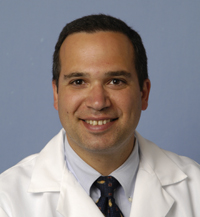Person
Kahana, Alon
|

|
Biography and Research Interest
The orbit is the anatomic structure that contains the eye and all of its associated tissues, including muscles, nerves, blood vessels and connective tissues. It is encased in a complex bony structure that protects the eye and separates it from the brain.
Orbital tissues have a unique embryologic origin in the neural crest, which is a transient population of cells that migrate from the invaginating neural tube to destinations throughout the body. Neural crest cells are responsible for tissues as varied as heart valves, blood vessels, bones, endocrine glands, and the autonomic nervous system. However, there is no other place in the body to which neural crest cells contribute and/or influence more cell types within such a small space than the orbit. The neural crest contributes directly or indirectly to most of the orbital bones, the orbital connective tissues (including muscle pulleys), sclera, corneal stroma and endothelium, trabecular meshwork, sensory nerves, blood vessels, iris, and extraocular muscles.
Diseases such as thyroid-related eye disease may be the result of derangements in neural-crest stem cells that are normally present in the orbit. Craniofacial syndromes such as Apert and Crouzon, as well as anterior segment dysgenesis syndromes of the eye, are also known to involve derangements in neural crest development. Dr. Kahana's research explores the biology of neural crest-derived tissues in the orbit by using zebrafish as a model system. Zebrafish are transparent during embryogenesis, are genetically tractable, and as vertebrates, they are remarkably good models for human biology and genetics. Dr. Kahana's research focuses on the signals that control neural crest migration into the eye and orbit, as well as the intricate processes that control neural crest cell fate. The ability of adult orbital tissues to trans-differentiate, as well as the unique biological behavior of a variety of orbital tumors and inflammatory processes, may be related to the neural crest origins of much of the orbit. This research will lead to the development of novel diagnostic tools as well as potential treatments for neural crest-related eye diseases such as congenital glaucoma and anterior segment dysgenesis syndromes, as well as for severe orbital diseases such as cancer and thyroid-related eye disease. In addition, understanding the behavior of neural crest-derived stem cells may allow us to utilize these adult stem cells therapeutically in the future.
Orbital tissues have a unique embryologic origin in the neural crest, which is a transient population of cells that migrate from the invaginating neural tube to destinations throughout the body. Neural crest cells are responsible for tissues as varied as heart valves, blood vessels, bones, endocrine glands, and the autonomic nervous system. However, there is no other place in the body to which neural crest cells contribute and/or influence more cell types within such a small space than the orbit. The neural crest contributes directly or indirectly to most of the orbital bones, the orbital connective tissues (including muscle pulleys), sclera, corneal stroma and endothelium, trabecular meshwork, sensory nerves, blood vessels, iris, and extraocular muscles.
Diseases such as thyroid-related eye disease may be the result of derangements in neural-crest stem cells that are normally present in the orbit. Craniofacial syndromes such as Apert and Crouzon, as well as anterior segment dysgenesis syndromes of the eye, are also known to involve derangements in neural crest development. Dr. Kahana's research explores the biology of neural crest-derived tissues in the orbit by using zebrafish as a model system. Zebrafish are transparent during embryogenesis, are genetically tractable, and as vertebrates, they are remarkably good models for human biology and genetics. Dr. Kahana's research focuses on the signals that control neural crest migration into the eye and orbit, as well as the intricate processes that control neural crest cell fate. The ability of adult orbital tissues to trans-differentiate, as well as the unique biological behavior of a variety of orbital tumors and inflammatory processes, may be related to the neural crest origins of much of the orbit. This research will lead to the development of novel diagnostic tools as well as potential treatments for neural crest-related eye diseases such as congenital glaucoma and anterior segment dysgenesis syndromes, as well as for severe orbital diseases such as cancer and thyroid-related eye disease. In addition, understanding the behavior of neural crest-derived stem cells may allow us to utilize these adult stem cells therapeutically in the future.
Non-Zebrafish Publications
